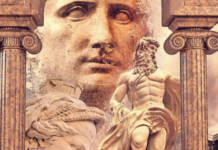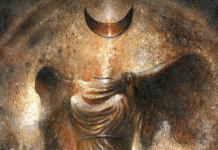
Our Gods Wear Spandex: The Secret History of Comic Book Heroes
, by Christopher Knowles, illustrated by Joseph Michael Lisner
Weiser Books, 1578634067, 233 pp. (incl. bibliography and index), 2007
Much of the early praise makes reference to Joseph Campbell and this influence is indeed clear. Our Gods Wear Spandex takes a look at classical mythology (ancient Egyptian, Greek and Roman in particular) and draws comparisons between comic characters and themes, starting with the earliest comics and moving right through to contemporary comics.
Observing the genealogy of myths, Knowles writes:
All superheroes are essentially savior figures. Unlike religious saviors, however, superheroes offer salvation as a tangible, unambiguous event. They exist, quite simply, to save others from physical danger – which explains their enduring appeal. Tales of their exploits address real anxiety and satisfy a deep need. The childhood need for a father or big brother to shield us from harm and solve our problems is an impulse we all feel. That is why superheroes traditionally enjoy greater popularity – with children and adults – in times of national stress. Children are remarkably sensitive to extential threats and they often internalize their parent’s anxieties. And adults often feel as vulnerable as children when confronting the fear of war or economic hardship.
It’s been many years since I read a “proper” comic. I read comics as a teenager, mostly the various X-Men titles and their spin-offs, along with the Spider-Man titles. I then put comics away. More recently I’ve gotten back into the habit in the form of graphic novels1. Not overly familiar with comic history or even contemporary comics, this book provided a useful reintroduction to the medium.
Taking note of the political climate at the time comics began to take of, Knowles writes that “[a]s America struggled to emerge from the Great Depression, the symbols and stories of the old gods reentered American culture. In the comic books, these gods and heroes of antiquity truly came alive and helped inspire America to regain its strength. The return of the old gods collided head-on with huge leaps forward in science and technology. At the same time, genetics prompted scientists to ponder the possibility of improving the race through genetic manipulation. Credible ideas about space travel were propounded to a public many of whom still believed there was intelligent life on Mars and Venus. Science, philosophy, religion and the occult all merged in a general yearning to overcome intractable human problems and improve mankind’s future”.
Knowles gives brief synopses of Spiritualism, Theosophy, the Hermetic Order of the Golden Dawn, and figures like Aleister Crowley, Bram Stoker, and H.G. Wells. As well, an overview of sci-fi stories inspired by occult themes transitioning to the pulps, penny-dreadfuls, detective stories with recognizable names like Tarzan, the Shadow, Doc Savage, Weird Tales; and particular authors such as Edgar Allan Poe, Howard Phillips Lovecraft, Clark Ashton Smith (must they all have three names?); the influence they had and noting some of their influences.
At times he is overly credulous of the mythological origins purported by some schools of philosophy and the occult, especially in regards to the fanciful origins of Freemasonry and Rosicrucianism leading back to the Knights Templar, with the subtle out “many believe…” frequently employed. They may “believe”, but this does not make this belief accurate or based on historically documented evidence. In other instances the history given is simply ill informed based on the texts referenced. For example, stating that Bram Stoker was a member of the Golden Dawn: he was friends with members of the Golden Dawn, such as a Pamela Colman Smith, but not a member himself.
However, these misgivings aside, it’s a book on comics, not documented occult history, and Our Gods Wear Spandex remains an intriguing introduction to the occult links and origins of many of America’s most notorious superheroes and supervillains.








